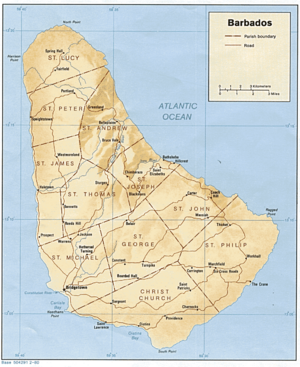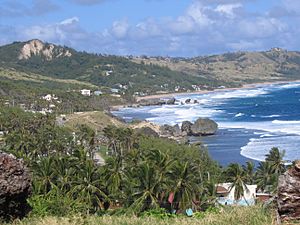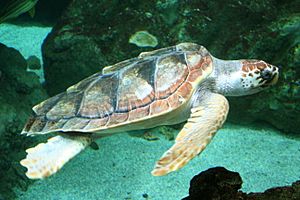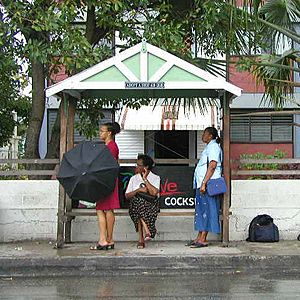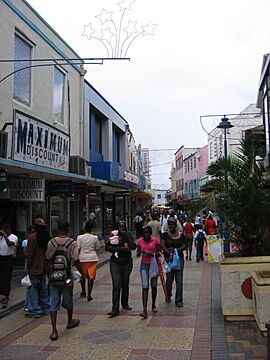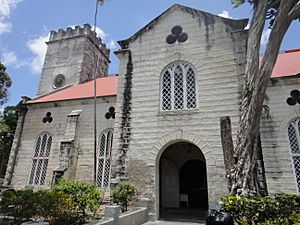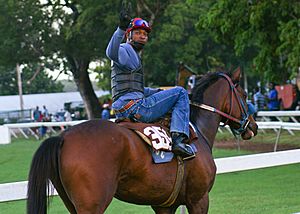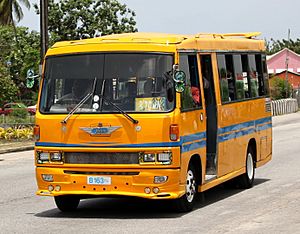Barbados facts for kids
|
Motto: "Pride and Industry"
|
|
|
Anthem: "In Plenty and In Time of Need"
|
|
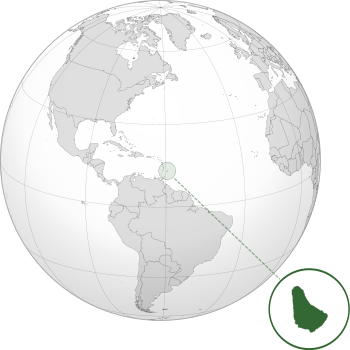 |
|
| Capital and largest city
|
Bridgetown 13°05′52″N 59°37′06″W / 13.09778°N 59.61833°W |
|---|---|
| Official languages | English |
| Vernacular language | Bajan Creole |
| Ethnic groups
(2020)
|
|
| Religion
(2020)
|
|
| Demonym(s) |
|
| Government | Unitary parliamentary republic |
| Sandra Mason | |
| Mia Mottley | |
| Legislature | Parliament |
| Senate | |
| House of Assembly | |
Quick facts for kids Independence
from the United Kingdom
|
|
|
• Part of the West Indies Federation
|
3 January 1958 – 31 May 1962 |
| 30 November 1966 | |
|
• Admitted to the UN
|
7 December 1966 |
|
• Joined CARICOM at the Treaty of Chaguaramas
|
1 August 1973 |
|
• Republic established
|
30 November 2021 |
| Area | |
|
• Total
|
439 km2 (169 sq mi) (183rd) |
|
• Water (%)
|
Negligible |
| Population | |
|
• 2023 estimate
|
281,998 (174th) |
|
• 2021 census
|
269,090 (174th) |
|
• Density
|
660/km2 (1,709.4/sq mi) (17th) |
| GDP (PPP) | 2023 estimate |
|
• Total
|
|
|
• Per capita
|
|
| GDP (nominal) | 2023 estimate |
|
• Total
|
|
|
• Per capita
|
|
| HDI (2022) | very high · 62nd |
| Currency | Barbadian dollar ($) (BBD) |
| Time zone | UTC−4 (AST) |
| Driving side | left |
| Calling code | +1 -246 |
| ISO 3166 code | BB |
| Internet TLD | .bb |
Barbados is a beautiful island country located in the Caribbean Sea. It's part of the Lesser Antilles and is the most easterly of all the Caribbean islands. Its capital and largest city is Bridgetown.
For a long time, starting in the 13th century, the island was home to the Kalinago people and other native groups. Later, in the late 1400s, Spanish explorers claimed Barbados. The Portuguese also visited but didn't stay. In 1625, an English ship arrived, and Barbados became an English and then British colony. During this time, large farms called plantations grew crops like sugar, and many African slaves were forced to work on them. Slavery was eventually ended across the British Empire in 1833.
Barbados became an independent country on November 30, 1966. For many years, Queen Elizabeth II was still its head of state. But on November 30, 2021, Barbados became a republic, which means it now has its own president as head of state. Most people in Barbados have African roots. Even though it's in the Atlantic Ocean, Barbados is strongly connected to the Caribbean and is a very popular place for tourists to visit.
Contents
- What's in a Name? The Story of Barbados
- A Quick Look at Barbados's History
- Where is Barbados? Geography and Climate
- Who Lives in Barbados? Demographics
- How Barbados Makes Money: Economy
- Learning in Barbados: Education
- Life and Traditions: Culture
- Fun and Games: Sports
- Getting Around Barbados: Transport
- Images for kids
- See also
What's in a Name? The Story of Barbados
The name Barbados likely comes from either the Portuguese word Barbados or the Spanish word los Barbados. Both mean "the bearded ones." People aren't sure if this refers to the long, hanging roots of the bearded fig-tree that grows on the island, or if it describes the Caribs who used to live there, who might have had beards.
A Quick Look at Barbados's History
Barbados has a rich history! The Kalinago people lived here since the 1200s, and even before them, other native groups called the island home.
- European Arrival: Spanish explorers visited in the late 1400s and claimed the island for Spain. It first appeared on a Spanish map in 1511. The Portuguese visited in 1536, but they didn't settle. They did leave wild pigs, which were a good food source for future visitors.
- British Colony: In 1625, an English ship arrived, and its crew claimed the island for King James I. The first permanent English settlers came in 1627, and Barbados became a British colony.
- Sugar and Change: In 1640, sugar cane was brought to the island. This changed everything! Barbados became one of the world's biggest sugar producers.
- Independence: On November 30, 1966, Barbados became an independent country.
- Becoming a Republic: On November 30, 2021, Barbados changed its government to become a republic, with its own president.
Where is Barbados? Geography and Climate
Barbados is in the Atlantic Ocean, to the east of the other West Indies islands. It's the most eastern island in the Lesser Antilles. Unlike its island neighbors to the west, Barbados is mostly flat. The land gently rises to a central area, with the highest point being Mount Hillaby, which is about 340 meters (1,115 feet) above sea level.
Bridgetown, the capital and main city, is in the parish of Saint Michael. Other important towns include Holetown, Oistins, and Speightstown.
How Barbados Was Formed: Geology
Barbados sits where the South American and Caribbean Plates meet. As the South American plate slides under the Caribbean plate, it scrapes off sediment. This sediment builds up, making Barbados slowly rise by about 25 millimeters (1 inch) every 1,000 years! This is why the island is made of thick coral, about 90 meters (300 feet) deep, where reefs grew on top of the sediment.
The land forms gentle "terraces" on the west side and slopes up on the east. Many coral reefs surround the island. In the northeast, in the Scotland District, the erosion of limestone has created cool caves and gullies. Some of these, like Harrison's Cave and Welchman Hall Gully, are popular tourist spots.
Barbados Weather: Climate
Barbados has two main seasons:
- Wet Season: From June to November, with more rainfall.
- Dry Season: From December to May.
Temperatures are warm all year round, usually between 21 to 31 degrees Celsius (70 to 88 degrees Fahrenheit). Gentle breezes blow constantly, making the tropical climate very pleasant.
Barbados is usually safe from the worst hurricanes because it's located just outside the main hurricane path in the south-east Caribbean. A big hurricane hits about once every 26 years on average. The last major one was Hurricane Janet in 1955.
Protecting the Island: Environmental Issues
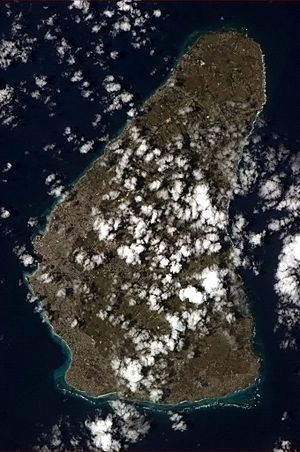
Barbados is a small island with many people, so protecting its environment is very important. The government works hard to keep the island clean and protect its beautiful coral reefs. They have also focused on protecting the underground aquifers, which provide the island's drinking water.
The Coastal Zone Management Unit (CZMU) helps manage human impact on the coast and seas. There are nearly 90 kilometers (56 miles) of coral reefs just offshore, and two protected marine parks have been set up on the west coast. Overfishing is a challenge that Barbados is working to address.
Barbados is home to four types of nesting sea turtles: green turtles, loggerheads, hawksbill turtles, and leatherbacks. It has the second-largest population of hawksbill turtles breeding in the Caribbean! It's important to avoid driving vehicles on beaches where turtles lay their eggs.
Sometimes, dust from the Sahara Desert in Africa travels all the way to Barbados. While some people think this dust might affect coral reefs or cause breathing problems, there isn't strong evidence to fully support these ideas.
Amazing Animals: Wildlife
Barbados is a special place for wildlife.
- Sea Turtles: Four types of sea turtles come to Barbados to nest: green turtles, loggerheads, hawksbill turtles, and leatherbacks. Barbados has the second-largest breeding population of hawksbill turtles in the Caribbean!
- Green Monkeys: You can also find green monkeys on the island. These monkeys originally came from West Africa and were brought to the West Indies in the late 1600s by slave trade ships.
Who Lives in Barbados? Demographics
In 2010, the population of Barbados was about 277,821 people. Most people in Barbados live a long time! In 2020, the average life expectancy was 80 years. Barbados and Japan have a very high number of people who live to be 100 years old or more.
Different Backgrounds: Ethnicity
About 90% of all Barbadians, also called "Bajans," have Afro-Caribbean roots. The rest of the population includes groups from Europe (like the UK, Ireland, Germany, Italy), Asia (mostly from Hong Kong and India), and other places like the United States and Canada.
Some of the main communities in Barbados are:
- Indo-Bajans: A growing group, especially from Guyana and India. Many small businesses are run by Muslim-Indian Bajans.
- Euro-Bajans: About 5% of the population, with roots in England, Ireland, Portugal, and Scotland. They brought folk music and names like "Scotland District." A small group called "Redlegs" are descendants of early Irish workers and prisoners.
- Chinese-Barbadians: A small but growing part of the Asian population. Chinese food and culture are becoming more common.
- Lebanese and Syrians: These groups form the island's Arab Barbadian community.
- Jews: Jewish people arrived in Barbados soon after the first settlers in 1627. Nidhe Israel Synagogue in Bridgetown is one of the oldest Jewish synagogues in the Americas, built in 1654.
- Romani people: In the 1600s, some Romani people were sent from the UK to work on plantations.
Speaking in Barbados: Languages
English is the official language of Barbados. It's used for government, business, and public services. The English spoken here is similar to British English. However, for everyday conversations, most people speak Bajan Creole. This language doesn't have a standard written form, but over 90% of the population uses it.
Faith and Beliefs: Religion
Religion in Barbados (2019) Anglican (23.9%) No religion (atheism, agnosticism, etc.) (21%) Pentecostal (19.5%) Other Christian, including Baptist, Moravian, Mormon, and Jehovah's Witnesses (16.5%) Seventh Day Adventist (5.9%) Methodist (4.2%) Roman Catholic (3.8%) Wesleyans (3.4%) Church of God (2.4%) Nazarenes (3.2%) Other religion, including Muslim, Jewish, and Rastafarian (3%)
Christianity is the largest religion in Barbados. The biggest group is Anglican (about 23.9% in 2019). Other Christian groups include Catholics, Pentecostals, Jehovah's Witnesses, and Seventh-day Adventists. The Church of England used to be the official state religion, but that changed after Barbados became independent.
About 21% of Barbadians say they have no religion, making them the second-largest group after Anglicans. Smaller religions on the island include Hinduism, Islam, the Baháʼí Faith, and Judaism. Barbados is a secular country, which means it guarantees freedom of religion or belief for everyone.
How Barbados Makes Money: Economy
Barbados is considered a high-income economy by the World Bank. It has a well-developed economy and a good standard of living. However, a 2012 study showed that some Barbadians (about 20%) live in poverty, and nearly 10% struggle to afford basic food.
- Past Economy: For a long time, Barbados's economy depended on growing sugarcane.
- Modern Economy: Since the late 1970s, the economy has grown to include manufacturing and tourism. Financial services and information services also bring in a lot of money from other countries.
- Recent Challenges: The economy faced challenges during global economic crises, like in 2008-2013 and again from 2017-2019. The COVID-19 pandemic also caused a decline in 2020. However, Barbados has been working to recover and grow its economy.
- Trading Partners: Barbados trades a lot with Canada, the Caribbean Community (especially Trinidad and Tobago), the United Kingdom, and the United States.
- Future Goals: The government is working to reduce unemployment, attract more foreign businesses, and sell off some state-owned companies. The European Union is helping Barbados modernize its financial services sector.
Barbados also has the third-largest stock exchange in the Caribbean.
Learning in Barbados: Education
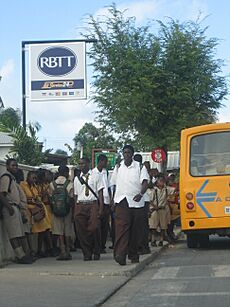
Almost everyone in Barbados can read and write, with a literacy rate close to 100%. The public education system is based on the British model. The government spends a good amount of money on education.
- School Age: All young people must attend school until they are 16 years old.
- Schools: Barbados has over 70 primary schools and more than 20 secondary schools. There are also some private schools.
- Higher Education: For college and university, students can attend the Barbados Community College, the Samuel Jackman Prescod Institute of Technology, Codrington College, and the Cave Hill campus of the University of the West Indies. Barbados also has medical schools for international students.
School Exams in Barbados
- Barbados Secondary School Entrance Examination: This exam is for 11-year-olds to decide which secondary school they will attend.
- Caribbean Secondary Education Certificate (CSEC): Students usually take these exams after five years of secondary school, around age 16. They are similar to O-Levels in the UK.
- Caribbean Advanced Proficiency Examinations (CAPE): These exams are for students who want to continue their studies after secondary school, often to prepare for university. They are like A-Levels in the UK.
Life and Traditions: Culture
Barbadian culture is a mix of West African, Portuguese, Creole, Indian, and British influences. People from Barbados are officially called Barbadians, but they are often called "Bajans" (pronounced BAY-juns).
- Crop Over Festival: The biggest cultural event is the Crop Over festival, which started in 1974. It's a huge celebration for locals and tourists, with music, competitions, and traditional activities. It features lots of calypso and soca music. The festival starts in early July and ends with a colorful parade on Kadooment Day, the first Monday of August.
- Art: Barbadian art has changed over time, influenced by its history and different cultures. Artists explore many styles, mixing traditional and modern ideas. They also connect with art from around the world, bringing new ideas while sharing Caribbean art.
Delicious Food: Cuisine
Bajan food is a tasty blend of African, Indian, Irish, Creole, and British influences. A typical meal includes a main dish of meat or fish, often marinated with herbs and spices, along with hot side dishes and salads. A common side dish is pickled cucumber or fish cakes. Meals are usually served with sauces.
The national dish of Barbados is cou-cou and flying fish with spicy gravy. Another traditional meal is pudding and souse, which is pickled pork with spiced sweet potatoes. You can find a wide variety of seafood and meats.
Barbados is also famous for its rum! The Mount Gay Rum visitor's center claims to be the world's oldest rum company, with records going back to 1703. Other rums like Cockspur Rum and Malibu are also from the island. Barbados is home to the Banks Barbados Brewery, which makes Banks Beer.
Music and Stars: Music
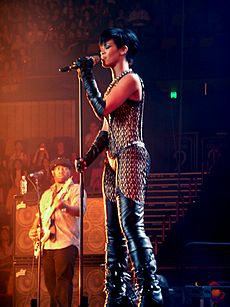
Barbados has a vibrant music scene. In 2009, the famous international pop star Rihanna, who is from Barbados, was named an Honorary Ambassador of Youth and Culture for the island. She is a nine-time Grammy Award winner and one of the best-selling music artists ever.
Fun and Games: Sports
Like many other Caribbean countries with British history, cricket is very popular in Barbados. The West Indies cricket team often includes several Barbadian players. Barbados has hosted major cricket events, including the final of the 2007 Cricket World Cup and the 2024 ICC Men's T20 World Cup. Many famous cricketers, like Sir Garfield Sobers and Sir Frank Worrell, come from Barbados.
In Track and Field, sprinter Obadele Thompson won a bronze medal in the 100m at the 2000 Summer Olympic Games. He was the first Olympic medalist for Barbados! Ryan Brathwaite won a gold medal in the 110 meters hurdles at the 2009 World Championships in Athletics.
Rugby is also enjoyed in Barbados. Horse racing takes place at the Garrison Savannah Racetrack near Bridgetown.
Basketball is becoming more popular, especially in schools and colleges. The Barbados men's national basketball team has had some international success. Polo is a popular sport among the wealthy on the island.
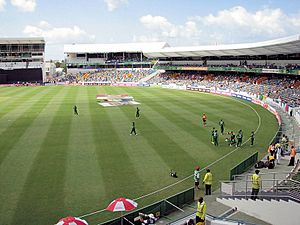
For golf, the Barbados Open was part of the European Seniors Tour for many years. The WGC-World Cup was held at the Sandy Lane resort in 2006.
Volleyball is popular, mainly played indoors. Tennis is also growing, and Barbados is home to Darian King, a professional tennis player.
Motorsports are also big, with the annual Rally Barbados event. The Bushy Park Circuit hosted the Race of Champions in 2014.
The island's trade winds and good waves make the southern tip perfect for wave sailing, a type of windsurfing. Barbados also hosts international surfing competitions. Netball is a popular sport for women.
Several players in the National Football League (NFL) in the US are from Barbados, including Robert Bailey and Ramon Harewood.
Getting Around Barbados: Transport
Even though Barbados is only about 34 kilometers (21 miles) wide, traffic can make journeys longer. Drivers in Barbados drive on the left side of the road.
Barbados is known for its many roundabouts. One famous one near Bridgetown has the Emancipation Statue of Bussa, a slave who led a rebellion.
- Public Transport: Getting around is easy with "route taxis" called "ZRs" (pronounced Zed-Rs). These small buses can get crowded but will take you to most places. There are also yellow minibuses and blue Transport Board buses. A ride on any of them costs 3.50 Barbadian dollars. Schoolchildren in uniform ride for free on government buses.
- Car Rentals: You can rent cars from local companies.
- Airport: The island's only airport is Grantley Adams International Airport. It has daily flights from around the world and serves as a travel hub for the Caribbean. The airport has been upgraded and is planning more expansions.
- Seaport: The Bridgetown seaport is the main port for cargo ships and cruise ships.
Images for kids
See also
 In Spanish: Barbados para niños
In Spanish: Barbados para niños




